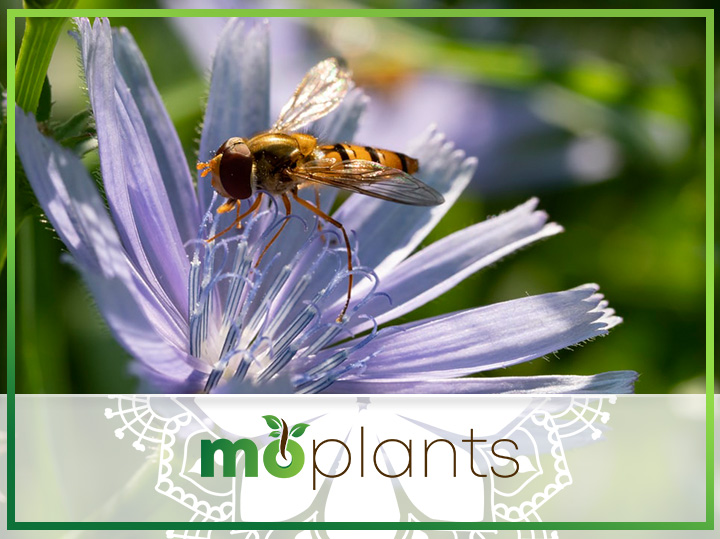Have you noticed any small and fast-moving winged insects flying around the colorful nectar-filled flowers in your home garden? If these tiny bugs have brown and yellow stripes but lack a stinger, they are most likely hoverflies – one of the most important pollinators in many ecosystems. Although they are pretty harmless, it is not uncommon for gardeners to look for tips on how to get rid of hoverflies as they can sometimes become a nuisance.
If a swarm of hoverflies has found a home in your garden and just won’t let you sit outdoors in peace, you should ideally look for ways to repel instead of killing them. However, before we delve into the ways to control the hoverfly population zigzagging in your backyard, let’s learn a little bit more about these intriguing creatures and why they might just be every gardener’s best friend.
What Are Hoverflies?
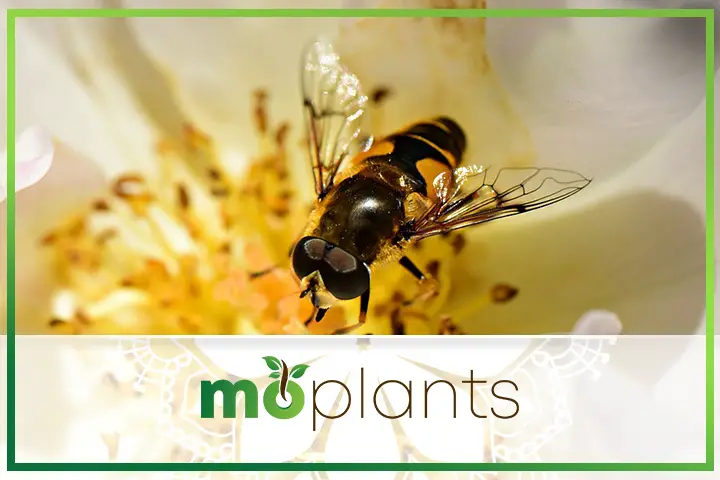
Hoverflies are a common sight in gardens across the country. These flying insects have slender and bright bodies that may look suspiciously similar to that of bees or bumblebees. Some species of hoverflies also bear a striking resemblance to wasps and yellowjackets, which may confuse some amateur gardeners. Moreover, they have short antennae, cylindrical shape, and a stout waist, though large hoverflies usually have a flat abdomen.
The adult flies feed on the nectar and pollen from different flowers. The nectar provides them with energy, while the pollen allows females to produce eggs that hatch within two to three days. The tiny hoverfly larvae then feed on aphids and other common pests found on plants. Since they don’t have eyes, these tiny slug-like creatures blindly move along the stems to devour any aphids they may come across. Researchers now believe that some species of hoverflies can find their prey through chemical odors.
These larvae eventually attach themselves to a plant stem and build a cocoon, where they spend around ten days during the summer months and longer during the winter. Once hoverflies emerge from their cocoon, the cycle begins again.
Lifespan of Hoverflies
Although it may vary with each species, most hoverflies have a lifespan of 12 days. However, there are a few types that can live up to 55 days.
Types of Hoverflies
There are about 6,000 species of hoverflies found across 200 genera. They exist in almost all parts of the world except a few cold regions and don’t cause any harm to humans.
Do Hoverflies Sting?
No, hoverflies do not bite or sting. Unlike wasps and yellowjackets, these winged insects do not have a stinger.
Hoverflies vs. Wasps
It is easy to mistake hoverflies for wasps owing to the bright bands of colors on their abdomen. Many botanists believe their appearance plays a crucial role in protecting them from their natural predators, birds. However, the main difference between hoverflies and wasps in the shape of their heads. While wasps have a distinctive head with a stinger, a hoverfly looks like a typical fly.
In addition, hoverflies only have a single pair of wings, while wasps and bees have two.
Are Hoverflies Beneficial to Your Garden?
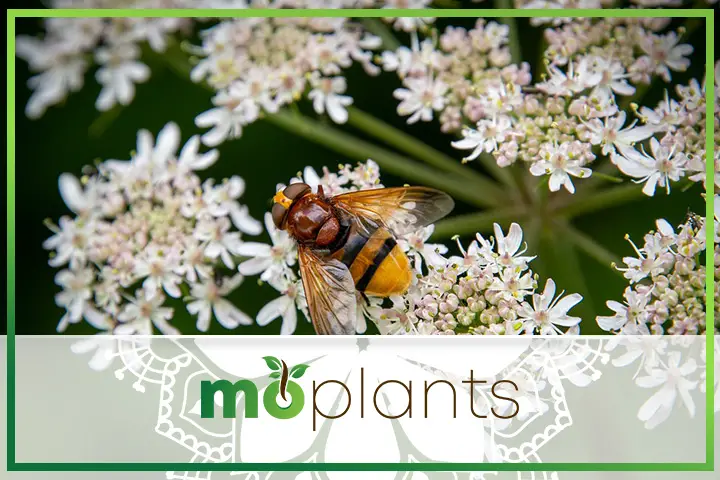
Hoverflies can play a crucial role in protecting your beloved plants from pest infestation, as they feed on aphids, leafhoppers, and other soft-bodied insects that can stunt the growth of your crops and cause the foliage to wilt. So, if you notice a sudden increase in the number of hoverflies in your garden, there is a good chance one or more of your plants have become heavily infested, and these flying bugs are repeatedly coming back to eat those pests.
Moreover, as mentioned above, hoverflies are excellent pollinators as they are attracted to flowers and can travel great distances.
How to Get Rid of Hover Flies
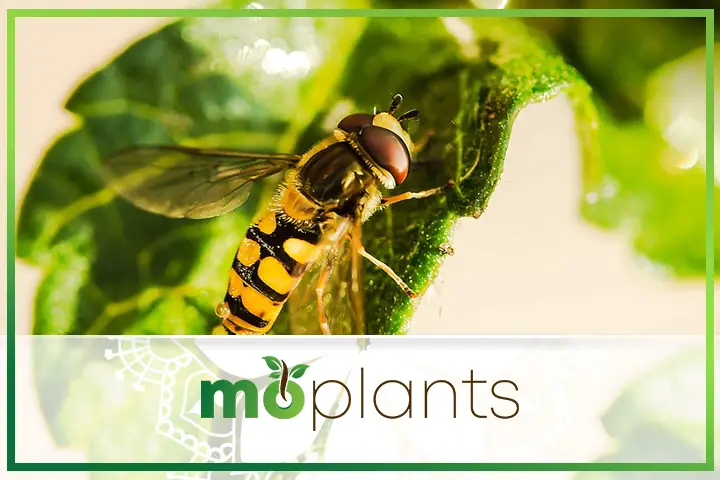
If hoverflies are constantly landing on your arms and face the moment you step into your garden, it may be time to drive them away.
Here are some easy-to-follow tips on how to get rid of hoverflies that all amateur and seasoned gardeners will find useful.
Make a Non-Toxic Hoverfly Repellant
Most store-bought insect repellants contain harsh chemicals that can be harmful to the plants and the environment. Hence, it is recommended to create your natural hoverfly repellant using items from your pantry.
The first recipe includes lemons and cloves, both of which are common kitchen ingredients. All you have to do is cut the lemon in half and put a clove inside it. Place this DIY repellant in the areas infested by hoverflies and watch as its citrusy smell repels the winged insects.
Alternatively, you can put pieces of fresh orange wrapped in a tea bag near plants that appear to have attracted dozens of hoverflies. You can also add a few drops of neem oil to increase the efficacy of this hoverfly repellant.
If these methods fail, you can use apple cider vinegar to repel hoverflies. Mix one part apple cider vinegar with two parts water and add a few drops of liquid dishwashing soap, peppermint oil, rosemary oil, and basil oil to the solution. Next, put the mixture in a spray bottle and spray it in hoverfly-infested areas. The strong scent of this repellant will keep them at bay for quite some time.
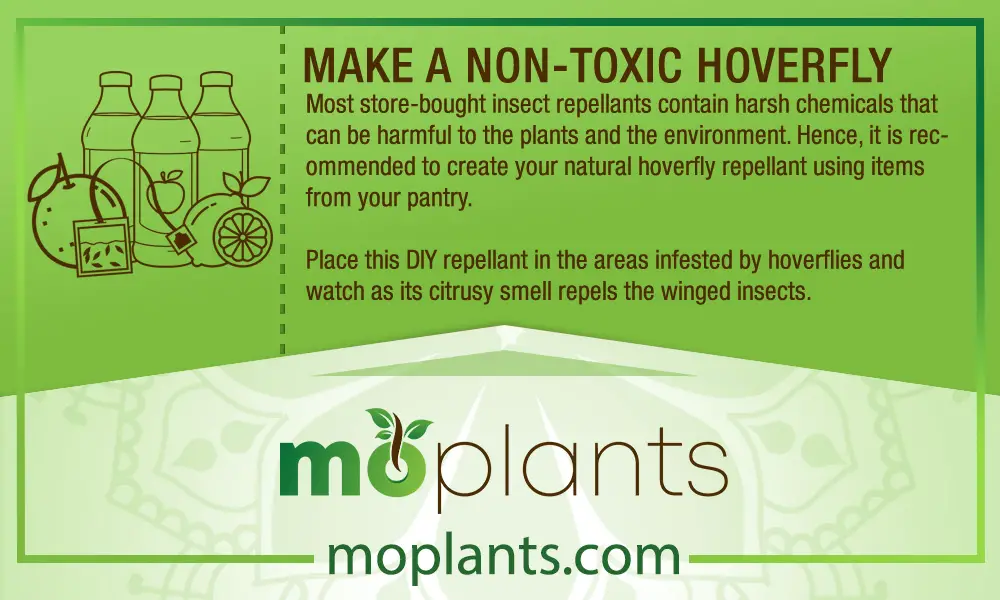
Remove Bright Flowers from Infested Areas
Hoverflies are naturally attracted to fragrant and bright flowers. Therefore, the best way to ensure they stop bothering you would be to move your colorful flowering plants to the outer edges of the garden. This would allow you to enjoy an evening tea or a meal on your patio without worrying about a fly landing in your cup or on your food.
If you want to go a step further, consider planting mint, lavender, basil, or bay leaf near the plants that are heavily infested by hoverflies. These herbs act as a natural repellent and can help keep these tiny creatures at bay.
It is also worth mentioning that hoverflies are extremely fond of wild mustard, coriander, dill, sweet alyssum, and wild carrots. So, if you have any of these herbs and gorgeous flowering plants in your backyard, you can consider transplanting them to another location.
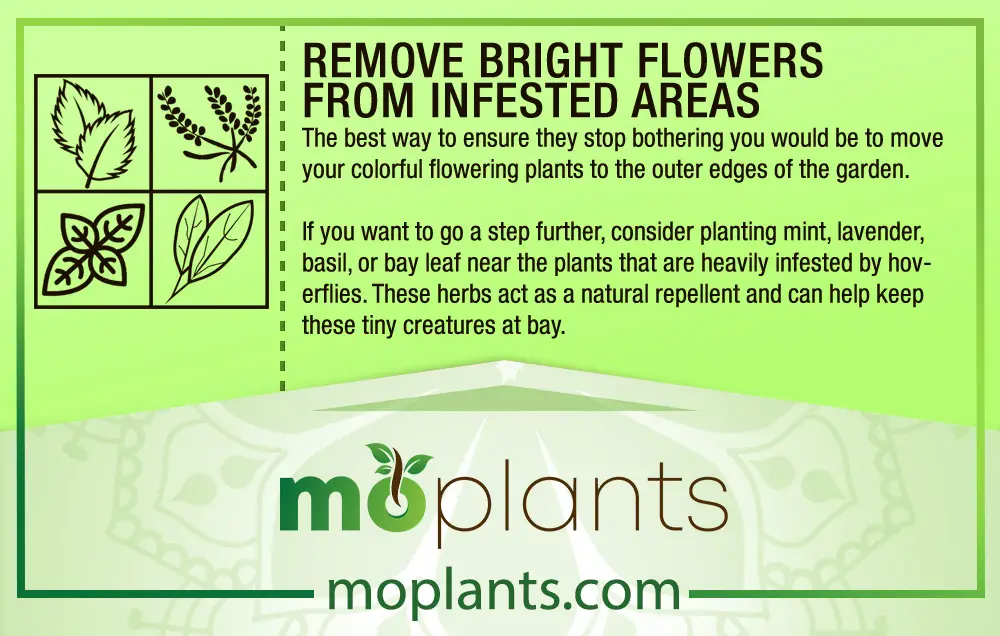
Repel Hoverflies with Essential Oils
Eucalyptus and lavender essential oils may be known for their healing and soothing properties, but did you know that you could also use them to repel hoverflies?
Pour a few drops of one of these essential oils on any fabric and place it in a hoverfly-infested area. The strong smell of these oils will drive the flying insects away from its surrounding, though you will have to replace the fabric or add more oil to it every couple of days.
If you cannot get your hands of eucalyptus and lavender oils, peppermint oil can also turn out to be a worthy alternative. However, it is probably not going to be as effective.
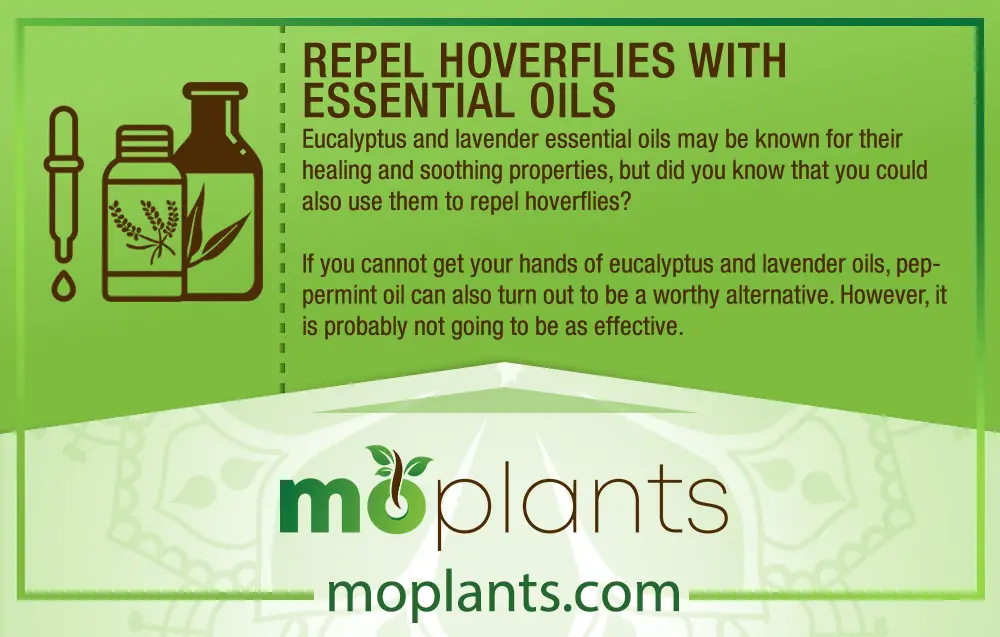
Use a Fan to Blow Hoverflies Away
Keep your porch and patio free of hoverflies by investing in a standard box fan.
This simple tip on how to get rid of hoverflies is most effective for small areas. Once you plug in the fan and turn it on, the flies in the vicinity won’t be able to fly around properly, causing them to clear the area and move to another spot. If you buy a stronger fan, you may even be able to make them flee their nest without causing any trouble.
Another option to remove hoverflies from your garden would be to create a wind tunnel. To accomplish this, position a fan at the end of a row of plants and turn it on. The strong wind will make it difficult for the flies to zap around the flowers, gradually driving them away for good.
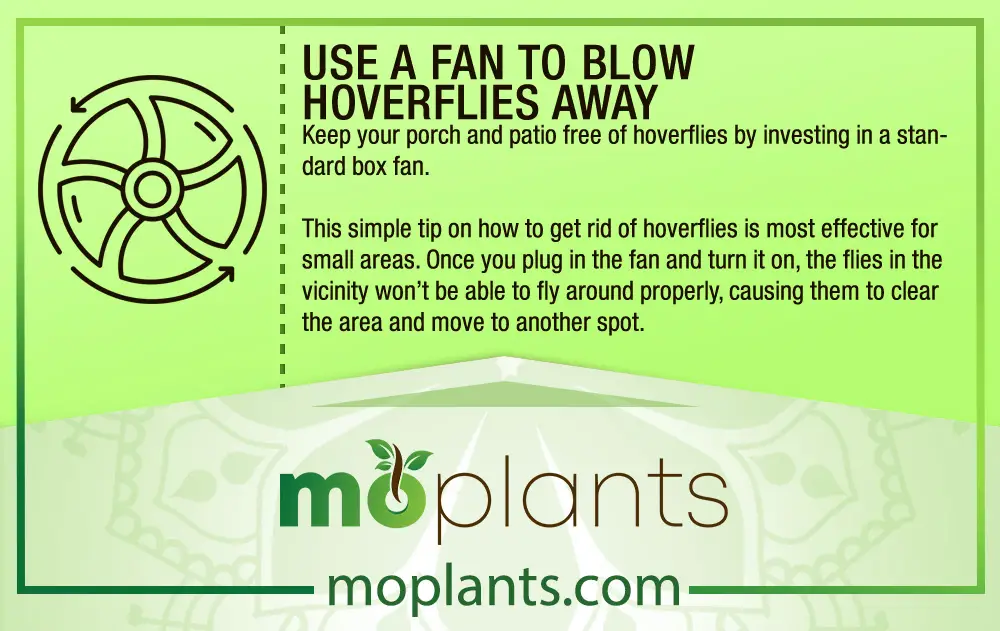
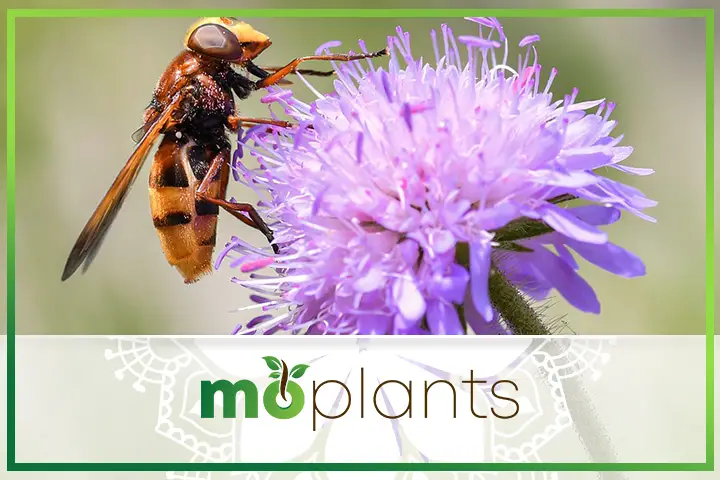
Keep Your Garden Free of Pests
As we already know, hoverflies are natural pest exterminators. Their larvae feed on aphids and other tiny insects that suck on plant sap, thus keeping the foliage and flowers healthy and happy. Hence, one of the most effective ways to control the hoverfly population in your garden would be to keep it clean and free of any infestation.
Overwatering is one of the biggest culprits behind pest infestation. When the plant receives more water than its roots can absorb, the soil becomes waterlogged. Soon enough, the roots begin to rot, attracting different pests and diseases. In addition, the pools of sitting water around the plant also serve as the breeding ground for mosquitoes and hoverflies. So, refrain from overwatering your plants.

Build a DIY Hoverfly Trap
If you have already tried most or all of the methods above, but the problem persists, it may be time to build a hoverfly trap using fly tape. This easily available product comprises a floral-scented piece of paper with glue spread on one side. The hoverflies are attracted to the sweet fragrance of the trap and fly towards it, only to get trapped in the glue.
You can hang this tape anywhere on your deck or patio or even in your garden.
Another way to remove hoverflies from your garden is by building a sugar water trap. As the name suggests, dissolve three teaspoons of sugar into a gallon of water and put the mixture in a bowl. Next, cover the bowl with plastic wrap and poke a few holes across it. The sweet scent of sugar will guide hoverflies to the trap, and once they get inside the bowl through one of the holes, they likely won’t be able to get out.
Alternatively, you can pour vinegar into a dish and add a drop or two of a mild dishwashing liquid to it. Cover the solution with plastic wrap and poke a few holes that are big enough for hoverflies to get in. Since these flies are also attracted to vinegar, they will enter the dish but won’t be able to fly out due to the soap.
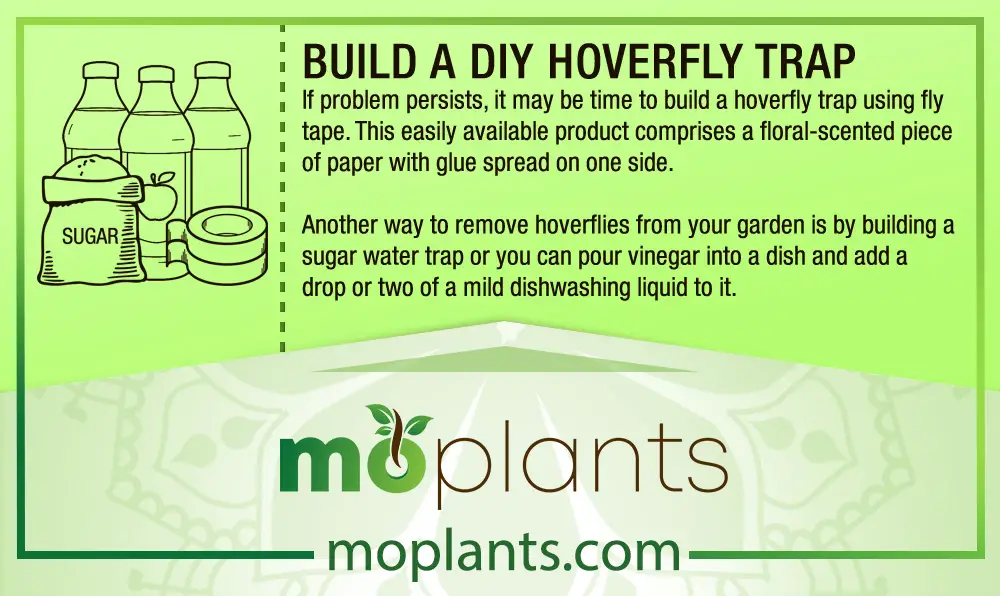
Invest in a Bug Zapper
Desperate times call for desperate measures.
If you have so far been unsuccessful in controlling the hoverfly infestation in and around your home, you may want to buy a bug zapper from your local supermarket or an ecommerce store.
These devices emitting a UV light, attracting winged insects such as mosquitoes and flies towards it. As soon as the bugs hit the area between the two metal grids placed inside the zapper, they get electrocuted.
You can find this hoverfly trap in a variety of shapes and sizes. Just place one on your patio in a spot that won’t draw too much attention. These devices are also rather affordable and last for several years. Additionally, they will help you get rid of other pesky insects as well.
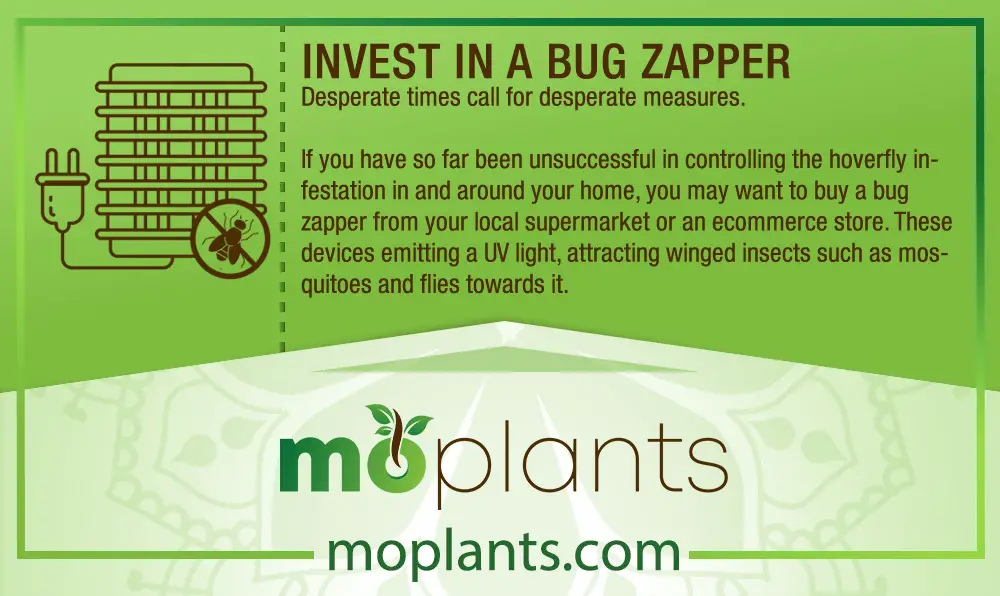
Spray Insecticide
Lastly, you can spray traditional insecticide around the area that is infested with hoverflies. The strong chemicals will not only eliminate the flies but also get rid of aphids, scales, mealybugs, and other pests that may have found home in your garden.
However, the biggest downside to this tip is that store-bought insecticides usually contain toxic ingredients. Exposure to these products can be rather harmful to young children and pets. Furthermore, most insecticides are bad for the environment.
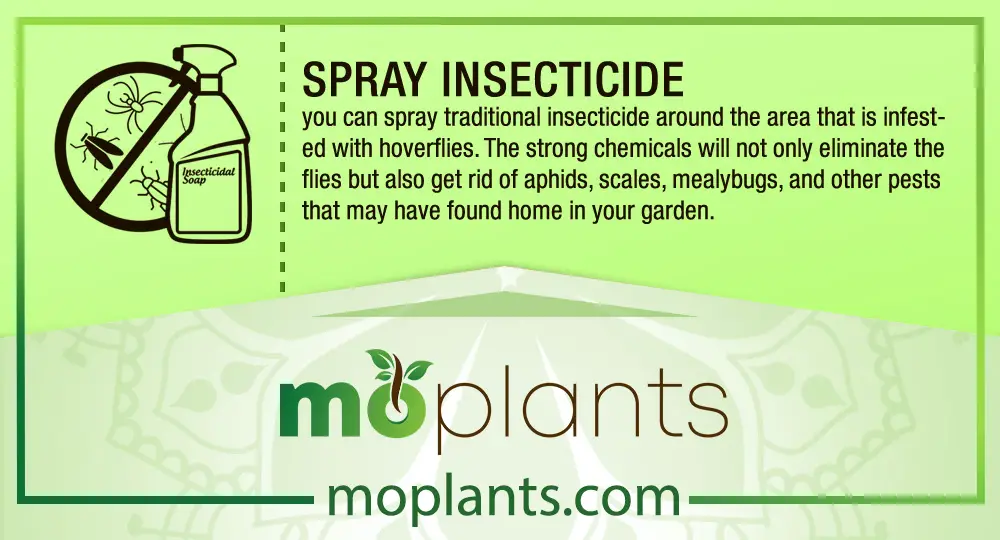
Infographic

Our Final Thoughts
Hoverflies are considered every gardener’s best friend. They are great pollinators and can help control aphid infestation by up to 80 percent. Although these winged creatures have yellow and brown bands like wasps and yellowjackets, they have the anatomy of a fruit fly. In other words, hoverflies cannot sting or bite anyone. Nevertheless, it is not pleasant to see a swarm of hoverflies take over your garden. So, if you are struggling to drive these winged insects away from your favorite plants, our tips on how to get rid of hoverflies will surely help you out.

